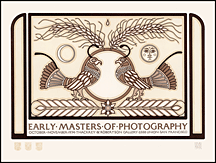
Click on image for detail
#(42) EARLY MASTERS OF PHOTOGRAPHY:
Edition of 424 of which 100 are signed 1-100, and 26 are signed A-Z as artist's proofs.
September 23, 1974 Six colors 24" x 18"
Client: Sean Thackrey & Sally Robertson, Thackrey & Robertson Gallery, 2266 Union Street, San Francisco CA 94123. Telephone (415) 567-4842 #40 to Harry Weininger A-Z artist's own use
Influence: Irish stonework and illuminated manuscripts
Art is not learning to draw, paint or sculpt. Art is learning to see. Before photography, everything was different. We couldn't see things quite right because our eyes weren't fast enough.
In 1872, Leland Stanford, who knew a lot about horses, suspected without positive proof that at one point in a fast trot, all four feet were off the ground. He commissioned the photographer Eadweard Muybridge to investigate the problem. Muybridge set his hand to the task and by 1876 succeeded in doing what had not been done before: he captured rapid motion clearly, and in sequence.
To illustrate these principles, he developed the zoöpraxiscope, which allowed him to project images creating the illusion of motion. Between 1884 and 1885, Muybridge published the eleven-volume work Animal Locomotion; an Electro-Photographic Investigation of Consecutive Phases of Animal Movement.
Because of a rich man's idle curiosity our eyes have permanently changed. We learned to see as we had never seen before. Answers are not what are important-it's questions that are important. Especially the simple ones: Why is the sky blue? Why is it dark at night? Where is everybody?
As I recollect, the quote "Where is everybody?" originates with Enrico Fermi, wondering where other intelligent beings might be is our universe, and why we have not encountered them.